The 9 Best Aquarium Vacuum Cleaners in 2025
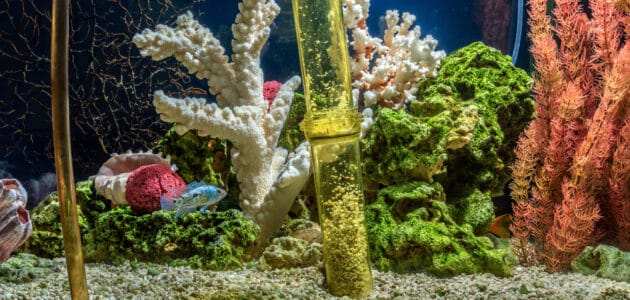
Part of being a pet owner is knowing the responsibility you have to keep your pets healthy and happy. And when you own pet fish, maintaining a clean environment for them to thrive in is key!
Now imagine finding a product that cleans your fish tank, but also takes away the tedium, extra work, and potential mistakes of more traditional aquarium cleaning methods. That’s why purchasing an aquarium vacuum cleaner, also known as a gravel vacuum, is a great choice for any dedicated fish owner.
But ensuring a balanced ecosystem for your precious pets while using modern equipment can seem daunting if you’ve never actually used one before. That’s why we’re here to help you find the perfect fit for cleaning your aquarium!
- Finding the Right Aquarium Cleaner
- Top 9 Best Aquarium Vacuum Cleaners 2025
- 1. Best Overall Aquarium Vacuum: Laifoo Aquarium Siphon Vacuum Cleaner Washer
- 2. Best Premium Aquarium Vacuum: Python No Spill Clean and Fill
- 3. Best Budget Aquarium Vacuum: Python Pro Clean Aquarium Gravel Washer
- 4. Easiest to Use: Luigi’s Fish Tank Siphon and Gravel Cleaner
- 5. Best for Fish Safety: LL Products Gravel Vacuum for Aquarium
- 6. Best Suction Vacuum: Aqueon Medium Siphon Vacuum
- 7. Best Hands-Free Vacuum: TERAPUMP Aquarium Cleaner
- 8. Best Electric Vacuum: Upettools Aquarium Gravel Cleaner
- 9. Best Battery-Operated Vacuum: EHEIM Quick Vac Pro Automatic Gravel Cleaner
- Complete Guide to Aquarium Vacuums
- Final Thoughts
Finding the Right Aquarium Cleaner
Remember that a clean aquarium makes for healthy inhabitants! The last thing you want is your little fish swimming through their own waste and leftover food. A perfectly maintained home means a better quality of life for your fish, and a longer lifespan overall.
Types of Aquarium Vacuum
It’s so important that you know what you’re looking for. So, let’s take a look at the two vacuum types you can purchase.
Siphon-Style Gravel Vacuum
Siphon-style gravel vacuums are manually operated and have a simplistic design, consisting at minimum of a plastic tube used to siphon water, and a connected hose to drain and refill the tank. They are by far the most widely used type of aquarium vacuum, being the more affordable and readily available option. They come in a wide range of sizes that can be used on all varieties of fish tanks.
Siphon-style vacuums not only siphon the dirt and debris from the tank but also pump the water out, meaning the tank has to be refilled with each cleaning.
While having to replace the water every time you clean your substrate may seem like a hassle, here’s another way to look at it. Partial but consistent water changes help to keep the ammonia content in your tank balanced – not changing your water can lead to toxic levels of ammonia in your tank and consequently a toxic environment for your fish.
Electric/Battery-Operated Gravel Vacuum
Electric gravel vacuums can be plug-in products or battery-powered, and both types operate faster than siphon-style vacuums. They work by pumping used tank water through an internal filter that traps waste and debris before returning the now clean water to the tank.
One great aspect of electric vacuums is that they aren’t limited by the amount of water in your aquarium, so you can technically clean for as long as you like.
The main difference between battery-powered vacuums and the other types is they have neither a hose nor a cord attached to the body of the vacuum, meaning there is much less to get in the way of your cleaning.
However, a significant drawback is that almost all electric vacuums will be significantly pricier than the average siphon vacuum.
What to Consider When Buying an Aquarium Vacuum
As we mentioned, keeping your aquarium clean is so important for the health of your finned friends, so you want to know what kind of vacuum is going to suit your needs most. Here are a few essential factors to keep in mind when considering which aquarium vacuum cleaner to buy.
Aquarium Size
The size of your aquarium might be the most important thing to keep in mind when shopping around for a cleaning kit. Most aquarium vacuums are made for specific tank sizes, designed and built to accommodate, based on the height and volume of the tank. We discuss the importance of aquarium size in our complete buying guide, as well as stating size suitability within each product review.
Suction
The suction power of your vacuum will inform how well it siphons fish waste and debris. While a stronger suction may seem like an advantage, it’s not always ideal for smaller tanks, as strong suction in a smaller tank may also risk inadvertently sucking up your fish.
The suction will generally be stronger in an electric vacuum, and larger siphon vacuums will usually have a stronger suction than small vacuums.
Substrate Quantity
Think of how much substrate you have in your tank. Depending on the size and depth it covers you may need a larger vacuum with more suction to get through all of the substrate in your tank.
Length of Hose
Regardless of your tank’s size, an aquarium vacuum with a longer hose is a good choice in the long run. Even if your fish tank is small, a long attachment means you won’t have to get your arms wet to reach every corner, which also minimizes spillage overall.
Types of Fish
The last thing you want while cleaning your aquarium is for your little pets to be sucked up into your gravel vacuum. If you have small fish and invertebrates that are at risk of being pulled out of the tank while cleaning, then you want to purchase a vacuum with a special attachment that will filter out these smaller creatures.
The only issue with these attachments is that they can easily be blocked up by larger debris in the tank. You’ll have to unblock the filter while cleaning, meaning a longer cleaning time overall.
Ease of Use
If you’re a less experienced owner, you may want to avoid an aquarium cleaner that is quite difficult to handle for cleaning. Just in general, most fish owners will prefer a cleaner that is simple to use over one that’s more unwieldy.
Making sure you have the right length of hose for your tank and buying a siphon with a clip that attaches your vacuum hose to your draining vessel should help if easy use is a big priority.
Below we’ll take a look at some of the best aquarium vacuums money can buy, so you can make the best and most informed decisions when purchasing your own product.
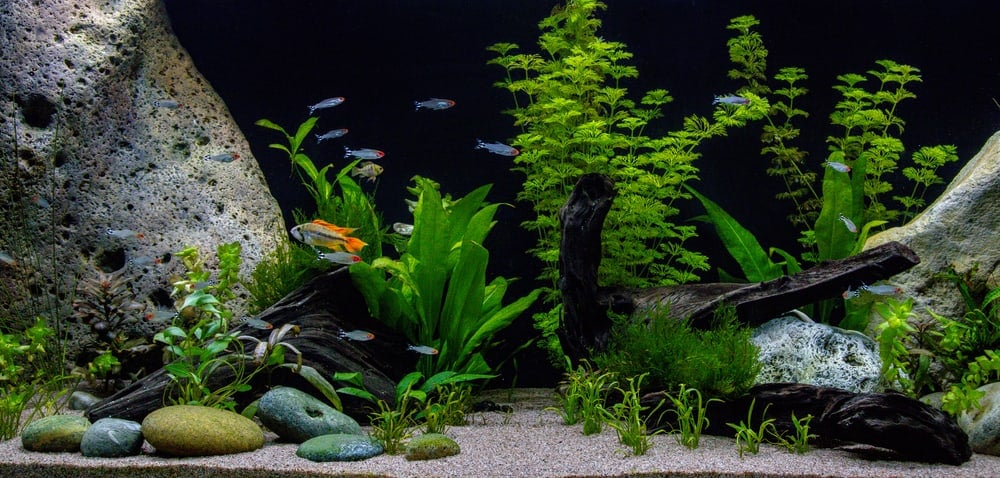
Top 9 Best Aquarium Vacuum Cleaners 2025
1. Best Overall Aquarium Vacuum: Laifoo Aquarium Siphon Vacuum Cleaner Washer
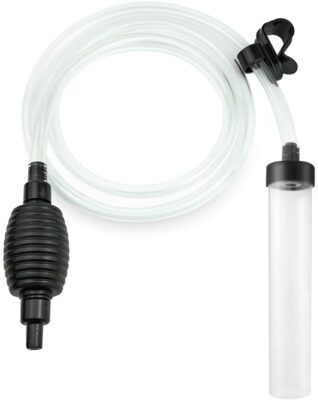
Editor’s Rating:
Why we like it: The Laifoo is a simple but reliable choice, constructed out of durable material so you can use it for years without having to replace it.
Aquarium Size
The Laifoo comes in two types – the 5 ft and 7 ft hose for accurate water drainage, depending on the size of your tank. It’s best used for small to medium aquariums.
Suction
While it doesn’t have the most powerful suction compared to other entries on the list, in particular the electric vacuums, the Laifoo does suction waste and debris sufficiently. It’s particularly well-suited to sand-bottom aquariums, as it’s powerful enough to siphon debris efficiently without actually sucking up the sand, which can be a concern.
Ease of Use
The Laifoo takes very little effort to start the siphoning process. The siphon ball only requires a few gentle squeezes to start sucking in water and debris, making it a simple and fast vacuum to operate.
Price
It’s a little more expensive than other vacuums of its kind, but the equipment is sturdy and made of thick polycarbonate. The hose does not kink, so you don’t have to worry about it bending. Laifoo also offers a 3-month warranty, with a full replacement or refund for any problems you might run into.
Extras
This product also comes with a black plastic hose tube to keep the hose secured to the bucket/vessel that the water is draining into. There is also a screen inside the tube to prevent any small fish or gravel from being sucked up.
Pros
- 3-month warranty
- Durable material
- Hose screen for filtering fish and gravel
- Bucket clip holds more securely than other varieties
Cons
- More expensive than other devices of this kind
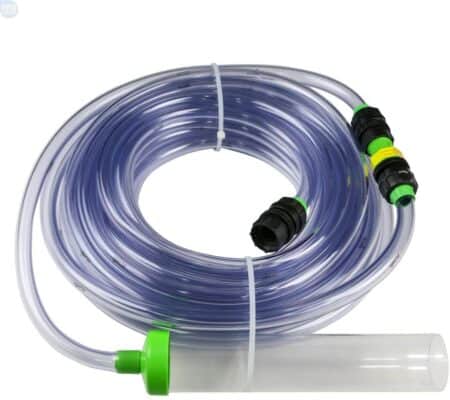
Editor’s Rating:
Why we like it: While it is pricier than the average aquarium vacuum, this option is definitely worth the price-tag! Long-lasting with strong water suction, the Python No Spill cleans all types of substrate and is the best aquarium cleaning product on the market.
Aquarium Size
Considering the length of even the smallest Python No Spill option, this vacuum is best suited for larger aquariums. We would recommend only using this item for tanks with a volume of over 20 gallons. Using this product on smaller tanks means you may risk crushing your fish when you refill, as there will be a large quantity of water flowing back into the tank at a higher rate.
Fortunately, Python also offers the Python Pro Clean so you can ensure your vacuum comes with Python’s reputation while still being more accessible for small aquarium owners.
Suction
One thing to keep in mind is that the Python No Spill is first and foremost for water drainage, hence the atypically long draining hose. Of course, it comes with its own gravel vacuum and cleans your tank substrate efficiently, but it also has an unusually powerful suction compared to other aquarium vacuums.
On one hand, this is great, as it means your tank will drain and refill quickly, as well as suck up more debris. But it also means you need to be careful while using it, to ensure that it doesn’t drain all of your water.
Price
As you can see the Python No Spill is the most expensive manual vacuum on this list. But that’s pretty much the only major complaint that can be made about this product. The higher price is likely due to Python being one of the more notable and trustworthy aquarium vacuum manufacturers on the market. Also, with a product that spans 25 to a whopping 100 ft of vacuum hose, the price does make sense.
Ease of Use
Just like its sister product on this list the Python Pro Clean, the Python No Spill does not siphon automatically, but requires a simple up and down movement where you submerge the open tube into your tank, remove it, and then submerge again. This begins the draining process.
Pros
- High quality material
- Durable, a long-lasting product as long if it isn’t directly damaged
- Strong suction
Cons
- More expensive than other vacuums
- This product offers no shorter hoses for small tanks
3. Best Budget Aquarium Vacuum: Python Pro Clean Aquarium Gravel Washer
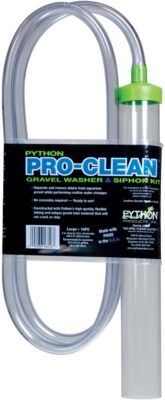
Editor’s Rating:
Why we like it: The Python Pro Clean Aquarium Washer is one of the best aquarium vacuums on the market. It has everything a novice or experienced fish owner could need, at a very affordable price.
Aquarium Size
The Python Pro Clean offers an array of vacuum sizes, so customers can purchase the perfect cleaner regardless of their tank size. These include a small/tall option for nano-aquariums, a mini cleaner for fish tanks up to 20 gallons, a small option for 10-20 gallon tanks, a medium option for up to 20-gallon tanks, and a large option for 20 to 50-gallon aquariums.
If you decide to purchase the Python Pro Clean, be sure to read the dimensions of each vacuum size carefully, as they can cause mix-ups.
Suction
Despite its size and simple design, the Python Pro Clean has surprisingly strong suction. Not only that but the siphon manages to suction well without draining water too quickly, so you have better control over how much water you drain while cleaning.
Ease of Use
The Python Pros tubing is very flexible and less rigid compared to other products. Python products are famously advertised as “no buckets, no siphons, no mess.” This means that the Python Pro is self-priming, so you need to use up-and-down motions in the aquarium water to start the cleaning process.
The Python also boasts siphon tubing made from UV-stabilized and non-porous material, to avoid any toxic material from entering your aquarium system.
Pricing
Python Pro is a very affordable option, with one of the best ratios of price to quality that you can find. Keep in mind the prices do change depending on the size of the hose you purchase, so a vacuum for a small tank is naturally going to be cheaper than a medium and large, etc.
Extras
The Python Pro is a simple package. It cleans your aquarium and drains the water, just as it was made to do. Sadly, it doesn’t have any extra goodies or special features like most other vacuums on this list.
Pros
- With one of the most flexible range of sizes on this list, you can find a Python Gravel Washer no matter the size of your tank
- Very affordable
- High quality, durable materials
- Strong suction
Cons
- The “no-siphon” style of draining may confuse people upon first use
- The large variety of sizes may also be confusing for potential customers
- No “extra” features that customers may seek out
4. Easiest to Use: Luigi’s Fish Tank Siphon and Gravel Cleaner
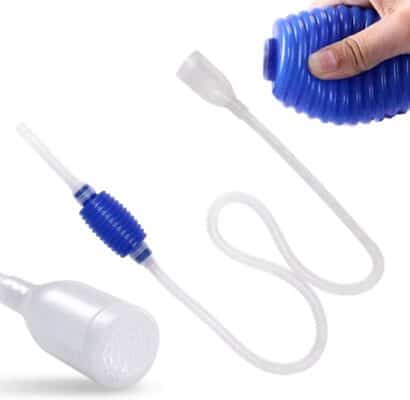
Editor’s Rating:
Why we like it: This model looks deceptively simply, but it has a lot of power behind it. Luigi’s Tank Siphon does exactly what you need it to do, and at a very low price.
Aquarium Size
Luigi’s Tank Siphon can drain water and clean substrate from tanks as large as 50 gallons. It’s meant to be an all-purpose siphon, so there is only one size.
Ease of Use
This siphon vacuum is marketed as being extra simple and easy to use, with only 4-7 squeezes of the “operation bulb” needed to start siphoning water from your tank. However, it can sometimes take longer to get going, which may result in a longer cleaning process overall.
Due to the built-in gravel filter, the tube may get clogged up on occasion.
Suction
Luigi’s Tank Siphon has an average suction overall, but suction can be improved if you continue to squeeze the siphoning bulb while you clean.
Price
Luigi’s Tank Siphon is very affordable and considering that there is only one size it’s definitely one of the cheapest vacuum options for large and extra-large aquariums.
Extras
This aquarium cleaner has an in-built filter that prevents any small fish from being sucked out of the tank during the draining process.
Luigi’s Tank Siphon is also exceptionally fast draining for a manual vacuum, draining up to 30 liters from your tank every 5 minutes. This makes it particularly efficient for water changes.
Pros
- Affordable
- Great for water changing
- Light-weight and portable
- In-built filter to avoid sucking fish and gravel
Cons
- May take a little longer than other products to build up necessary pressure for water draining and suction
- Blockage in gravel filter means you will have to repeat the process from the beginning every time you need to clean out the tube
5. Best for Fish Safety: LL Products Gravel Vacuum for Aquarium
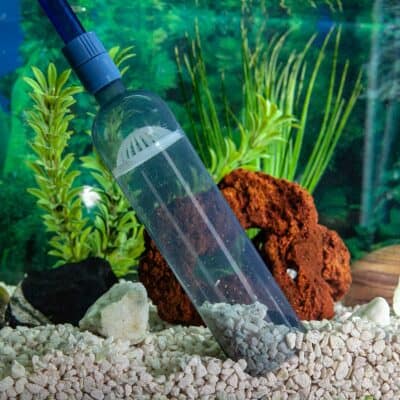
Editor’s Rating:
Why we like it: The LL Products Gravel Vacuum is a reliable piece of equipment that gets the job done, plus it comes with an extra minnow net to keep your aquatic friends safe during the cleaning process.
Aquarium Size
This aquarium cleaner is one of the larger vacuums on our list, meaning it’s much better suited for medium and larger tanks. The LL Vacuum works best on 20 to 55 gallon aquariums. If your tank is smaller than 20 gallons you will want to consider purchasing a smaller vacuum.
Suction
Has a fairly strong suction that cleans substrate well and will drain your aquarium quickly.
Ease of Use
The LL Vacuum has some great features, but it can be somewhat complicated to use initially as the vacuum needs to be assembled beforehand.
Otherwise, it operates as most other manual aquarium vacuums do.
Price
The LL Gravel Vacuum is certainly more expensive than some other siphon-type vacuums on this list. This may be because the LL Gravel Vacuum is an industrial size cleaner that is bigger and has to pump more water than smaller aquarium cleaners.
Extras
This product comes with the added benefit of a minnow net so that your fishy friends can be easily moved out of the way of the siphoning tube. It makes for an easier and safer clean, vastly improving the efficiency and overall experience of cleaning with this vacuum.
It also comes with a shut-off valve that allows you to control the flow of water when refilling the tank, so you can ensure the water flow doesn’t disturb your fish.
Pros
- Comes with shut-off valve for careful refills
- Free minnow net for safer cleaning
- Ideal for medium to large tanks
Cons
- The 8-foot siphon hose can be unwieldy when used on shallow tanks
- Not suitable for small tanks
6. Best Suction Vacuum: Aqueon Medium Siphon Vacuum
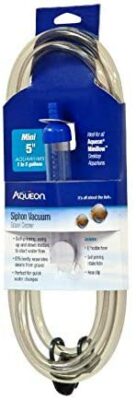
Editor’s Rating:
Why we like it: The Aqueon is a great little sucker, effectively siphoning debris and waste from both gravel and sand substrates.
Aquarium Size
The Aqueon comes in five different sizes, with varying tube sizes and hose lengths to suit all aquarium owners. Aqueon vacuums can be found to fit anywhere from a 1-gallon nano-aquarium to 55+ gallon large aquariums.
Suction
The suction on the Aqueon is exceptionally strong, so much so that it may suck up pieces of gravel and causes blockages in the tubing. Well, it has more than enough suction to siphon waste and debris, some extra care is needed to ensure it doesn’t suck up the other contents of your tank.
Ease of Use
The Aqueon is another self-priming cleaner. You only need to move the intake tube in an up-and-down motion to prime the siphon and get the water pumping.
Unfortunately, the siphon tube is fairly wide and can be difficult to use if you want to suck gravel from smaller and hard to reach places.
Price
It’s easily one of the most affordable aquarium cleaners on the market. If you’re looking for an affordable no-strings purchase, the Aqueon is a great option.
Extras
The Aqueon also comes with a clip that can be used to attach the vacuum hose to the side of the bucket you use for draining, lowering chances of spillage while draining your aquarium.
Pros
- Great price
- Variety of sizes
- Strong suction for cleaning
- Comes with a hose clip for secure cleaning
Cons
- Suction is so strong it may suck up gravel and small fish
- Siphon tube may be too wide for some areas of your tank
7. Best Hands-Free Vacuum: TERAPUMP Aquarium Cleaner
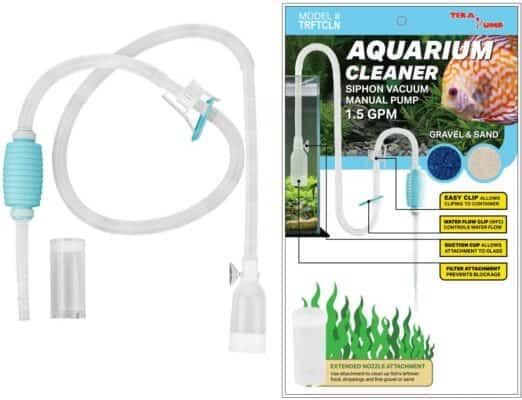
Editor’s Rating:
Why we like it: The Tera Pump comes with a variety of helpful features that means it can fulfill most fish-owners needs. The hands-free options, as well as separate nozzles for substrate-cleaning and water-changes makes it a real gamechanger!
Aquarium Size
The TeraPump comes in three sizes: small, medium, and large. You can purchase a vacuum for any aquarium size under 55 gallons.
Suction
The TeraPump has below average suction power, though some extra pumps of the siphon bulb can improve the suction somewhat.
Ease of Use
Like most siphon-style vacuums this one is fairly user-friendly and comes with a set of detailed instructions in case you have any issues. You shouldn’t, as using the TeraPump is as straightforward as using most other manual aquarium cleaners. Just submerge it in the water and begin squeezing the hand pump.
One negative when it comes to using the TeraPump is that it isn’t the best vacuum to purchase if you have smaller fish varieties, as it can suck up particularly small fish.
Price
While it isn’t as cheap as some options on this list, the TeraPump is still a reasonably affordable option for you. On the pricing scale, it’s a mid-tier option. Not the most expensive but still pricier than the cheapest options.
Extras
The TeraPump comes with two nozzle types: a longer nozzle for cleaning, and a shorter nozzle for draining water. It is equally useful as a substrate-cleaner and a water-changer.
It also has an exclusive pump filter that can discharge dirt and waste from sand as well as water.
The suction-cup and hose clip also combine to create a unique hands-free option, which is very appealing for when you want to change your aquarium water but don’t need to clean your substrate.
Pros
- Comes with clear instructions for use
- Has separate nozzles for more effective water changes and debris cleaning
- Filter that cleans sand substrate more effectively
- Hands-free options
Cons
- Can suck up smaller species of fish through the siphon-tube
- Below average suction
8. Best Electric Vacuum: Upettools Aquarium Gravel Cleaner
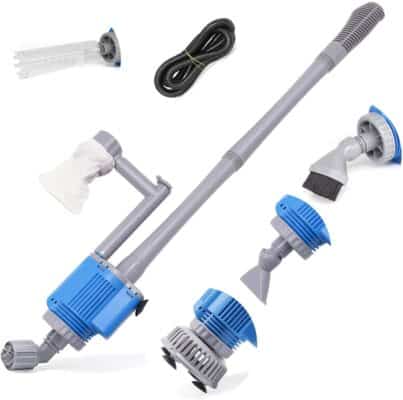
Editor’s Rating:
Why we like it: The best electric aquarium vacuum currently available, the Uppettools Aquarium Cleaner is a 6-in-1 cleaner. It serves as a sand washer, water filter, debris cleaner, water shower, water changer, and promotes water flow.
Aquarium Size
The Upettools aquarium cleaner has 4 extension tubes that can be used to adjust the length of the vacuum, making it suitable for tanks of all sizes.
Suction
The Upettools suction is very strong, and some care needs to be taken to avoid sucking up gravel and sand. Rather than touching the vacuum tube to the substrate, you can hold it a couple of inches above the substrate and it will still suction waste effectively.
Ease of Use
This vacuum needs to be assembled before you can start cleaning your tank. There are quite a few parts that make up the Upetools Aquarium Cleaner, but there are instructions you can use to put everything together and it shouldn’t take more than five minutes. Unfortunately, as simple as the assemblage is, the constructions can be somewhat confusing.
The vacuum needs to be placed inside the water before being turned on, or it won’t start.
Price
The Upettools Aquarium Cleaner is indeed pricier than other items on this list, but that’s unavoidable when you’re choosing an electric device over manual operation. We believe a good electric cleaner is worth the price, as less manual motion that is needed in a siphon-style vacuum means it’s less likely to develop wear-and-tear, so should last longer.
The Upetools team also promises a Lifetime Warranty for quality-related issues.
Extras
This vacuum comes with 4 different attachments for different uses. This includes a brush head for cleaning the walls of your tank, a corner suction inlet for changing water and cleaning sand, a duckbill suction inlet for gravel cleaning, and a water intake strainer for refilling your tank after cleaning.
Pros
- Unlike other items on this list which are siphon-style manual vacs, this product does not drain your tank, minimizing time spent on cleaning substrate
- Lifetime warranty
- Provides 4 different attachments for varying uses
Cons
- Cannot be purchased in operating order, needs to be assembled
- Package instructions can be confusing
9. Best Battery-Operated Vacuum: EHEIM Quick Vac Pro Automatic Gravel Cleaner

Editor’s Rating:
Why we like it: The EHEIM Quick Vac is easy to operate and will clean your substrate without the extra hassle involved with manual and plug-in electric cleaners.
Aquarium Size
While the EHEIM could technically clean a tank of any size, keep in mind that the vacuum itself is only 24 inches long. An aquarium that is significantly taller may make cleaning difficult.
Suction
Unfortunately, suction is one of the weaker points of the EHEIM Quick Vac. It doesn’t have a strong suction at all, surprising for an electric vacuum. It can still clean sufficiently, but it may take a little longer, to get all the nitty-gritty bits in the substrate.
Ease of Use
The EHEIM Quick Vac does need to be assembled before use, but the process is quite straightforward and should only take a few minutes.
Operating takes little more than the click of a button before it begins filtering the waste particles from your tank. Just make sure you have your 4 AA batteries fitted inside. Once inside, you can simply hover the vacuum over the gravel you’d like to clean. Push the Quick Vac down on the substrate you’d like to clean, and voila!
It can operate for up to 4 hours, so you’ll get a lot of use out of it before batteries need to be replaced. And don’t be scared to get in there – the EHEIM Quick Vac can be fully submerged up to 3ft in your aquarium.
Pricing
Sadly, the price may be a stickler for some – this product is the most expensive vacuum on the list. It’s worth it if you have the extra cash, but if you’re looking for something a little less spendy you may want to go for a manual aquarium vac instead.
This product also comes with a 2-year warranty from EHEIM.
Extras
In case you forget to pick up some batteries for your battery-operated vac, it’s been taken care of for you. It comes with 4 AA batteries so you can get cleaning right away.
It is also fitted with a fine mesh cartridge that filters and holds all of the debris in your tank, from the largest waste particles to the tiniest.
Pros
- Comes with batteries
- 2-year warranty
- No extra items needed for cleaning
- Mesh cartridge that can remove even very fine debris
Cons
- More expensive than most aquarium vacuums
- Weak suction
Complete Guide to Aquarium Vacuums
Here’s everything you need to know about aquarium vacuums.
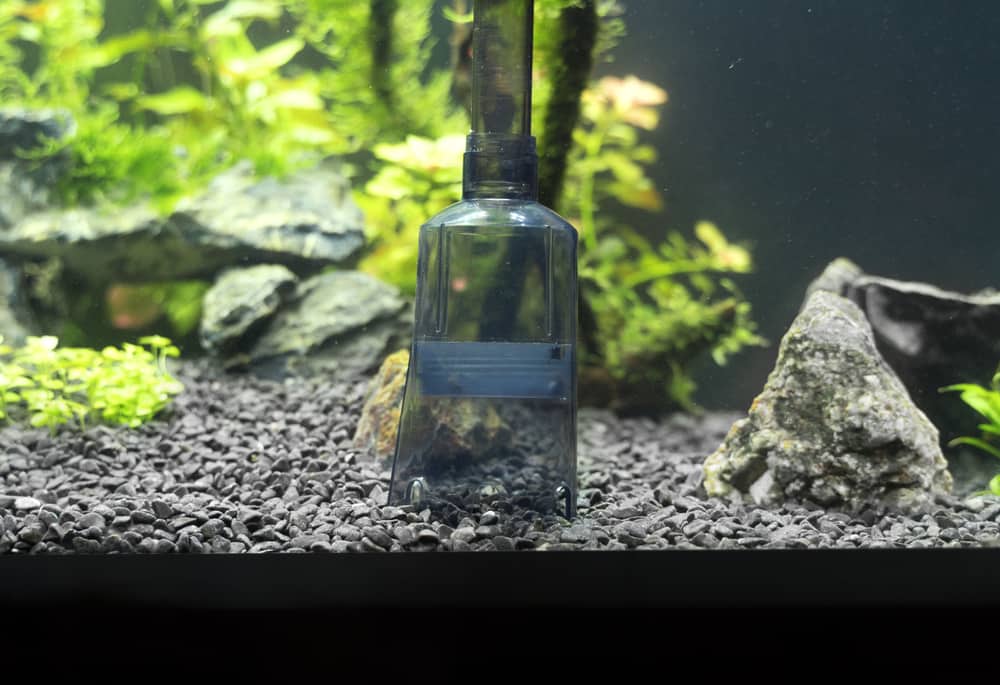
What Is an Aquarium Vacuum?
An aquarium vacuum is a piece of cleaning equipment used to clean the substrate in your home aquarium. A substrate is a layer of loose material at the bottom of your aquarium and can include gravel, pebbles, sand, soil, or whatever else acts as the floor for your pet’s home.
An adequate vacuum will clean not just the surface of your substrate, but it should also siphon out any harmful waste, debris, or leftover fish food that may be decomposing underneath the top layer of substrate.
A basic siphon-style aquarium vacuum consists of a thick tube made of rigid plastic, either polycarbonate or polyethylene. It is usually around 2 inches in diameter, with one end opened and the other connected to a long and flexible hose that drains the water into a bucket on the ground below the tank. Gravity allows the siphon to pull water carrying substrate waste from your aquarium and into the bucket. Nice and simple!
Why Should You Use an Aquarium Vacuum?
The better question might be – why shouldn’t you?
Aquarium vacuums are super-efficient and inexpensive (especially if you go with a siphon-style vacuum) and by far the easiest method for cleaning substrate. There are few viable reasons not to purchase an aquarium vacuum, especially if you want to provide the safest and cleanest possible environment for your aquatic friends.
Remember that you don’t just clean the fish waste and food out of your substrate because it might look dirty – you do it because a dirty environment will harm the health of your fish in the long run.
Debris that has been left too long can lead to a build-up of toxic ammonia, and though a basic filter helps to keep ammonia levels balanced in your tank, waste that is left too long will overwhelm the delicate ecosystem within the tank.
Basically, waste that is left in the substrate for too long will make your fish sick. Using an aquarium vacuum is a simple way to avoid such a problem in the future.
Not only that, but partial water changes are also essential in maintaining a healthy bacterial colony for your fish. This doesn’t apply to electric vacuums, but manual aquarium cleaners all drain your water, making a vacuum cleaning session the perfect opportunity to change the water in your tank as well.
The Importance of Aquarium Size
You should be thinking about how you might use a vacuum in your aquarium. If it’s a deep tank, then you want a gravel vacuum with a hose long enough to reach the bottom. And of course, the bigger the vacuum, the better suited it will be for cleaning larger tanks.
Not only that but using the wrong size of vacuum can have disruptive effects on any fish that may still be in your tank while you clean, so it’s also safer for your pets to make sure that your vacuum cleaner is the right size.
Of course, the length of the hose should be long enough that your siphon can reach the bottom layer of your tank, but short enough that you don’t end up with excess hose that gets in the way of the cleaning process.
You should choose your tube based on how much area you need to clean in your tank.
Here is a quick guide on how to choose the right size tube for your tank.
Mini: Nano aquariums under 5 gallons will take a standard vacuum tube of 1 inch.
Small: A small aquarium (between 5 and 20 gallons) should take a standard vacuum tube of around 1.5 inches.
Medium and Large: Tanks with a volume of over 20 gallons should take a standard vacuum tube of 2 inches or larger.
An Additional Aquarium Vacuum
While you want to ensure that you have the correctly sized vacuum for your tank, you may want to consider buying a second smaller vacuum, either siphon-style or electric. That way you can use the larger vacuum for general cleaning and consistent draining, and a smaller vacuum for the more finicky areas of your tank, like around plants, ornaments, and getting into corners of the tank.
How to Use an Aquarium Vacuum
Using an aquarium vacuum depends entirely on what kind of cleaner you have purchased. Just remember, all siphon-style vacuums will drain the water from your tank, so you’ll need a bucket or some kind of vessel to collect the draining tank water.
Electric/Battery-Operated
Most electric vacuums only require you to press a button before they can start cleaning. Unlike siphon-style aquarium vacuums, automatic cleaners don’t remove the water from your tank: they simply filter it inside the machine itself before letting it back out into the tank. The process should take much less time than it would be using a siphon.
Siphon-Style: Self-Priming
A self-priming aquarium vacuum is one that will start vacuuming without you needing to pump a siphon bulb or ball. Instead, you simply need to submerge the siphon tube, then move it in and out of the water a few times to start the siphoning process. Here is a helpful video tutorial to show you how it should be done:
As you’ll see in the video, the key to siphon-style vacuums is to make sure that the opening of the hose is lower than the siphon tube. This allows gravity to pull the water quickly through the tube and into your bucket.
Siphon-Style: Manual
Some siphon-style vacuums have to be primed manually for water flow. This is usually done with a siphon bulb, ball, or hand-pump. But don’t be discouraged – it’s actually a very simple process.
Just submerge the siphon tube fully in your tank (as you do with a self-priming vacuum) and squeeze the siphon tool several times. This number will change per product, but it shouldn’t take much more than 7 or 8 pumps. You’ll know it’s working when the water starts flowing into your bucket. Some vacuums may need a few extra squeezes while cleaning to maintain suction.
How Often Should You Vacuum Your Aquarium?
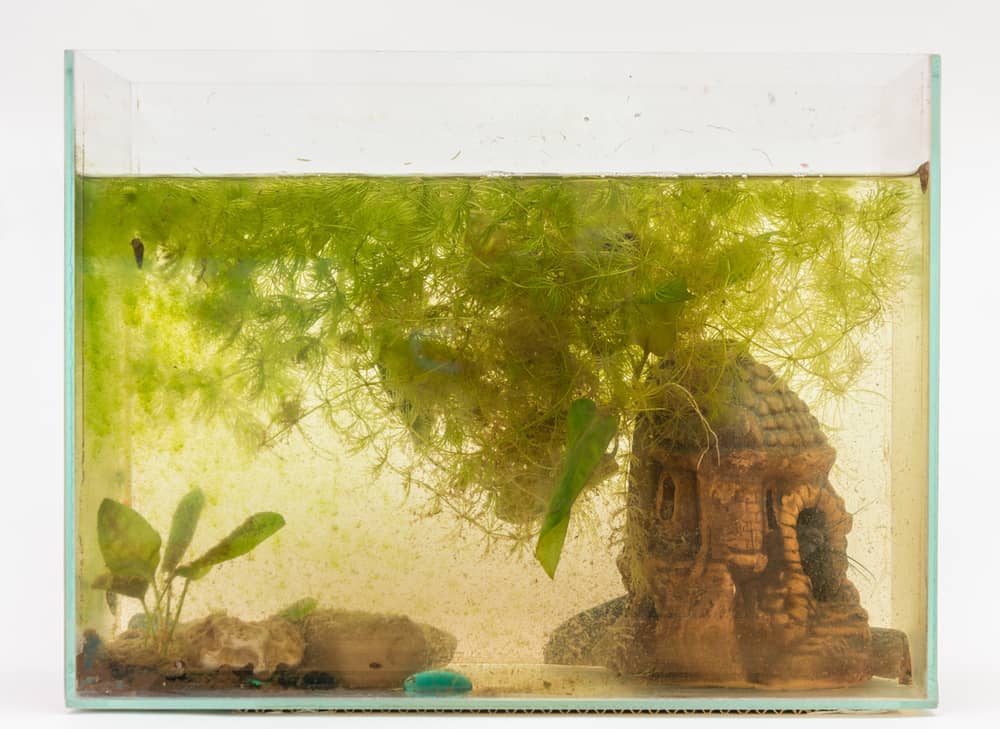
It can be tricky figuring out exactly when to vacuum your aquarium. It depends on several factors: the type and number of fish in your tank, the size of the aquarium, and the filter system you use. While some may go by the hard-and-fast rule to clean your aquarium every week, that isn’t always the case. Some fish-keepers may only need to clean once a month, or worse – every day!
A hot tip for establishing a cleaning schedule is to keep a regular eye on the state of your aquarium.
Fish Numbers
The more fish you have, the more often you should be cleaning. More fish means more fish excrement will build up inside your tank and require more frequent gravel cleaning.
Fish Type
Consider the species you have in your tank. Because yes, certain types of fish are a LOT messier than others, and it helps to know how often your fish are going to make waste, so you know when you need to clean.
Goldfish, plecos, and larger cichlids are common examples of pet fish that poop on an annoyingly frequent basis. Get to know your fish’s natural cycles and you’ll have a better idea of your cleaning cycle.
Fish Behavior
A pretty direct way of gauging the state of your tank (if you can’t see the clouds and drifting pieces of decomposing waste anyway), is simply by looking at your little fish. Unhealthy levels of waste and debris will start to affect your fish quickly, and they’ll let you know this in their behavior.
There are a host of ways to tell if your fish is unwell, but at the end of the day, any unusual behavior is a sign that something is wrong. Stiff or clamped fins, minimal appetite, and overall lethargy are just some of the ways you can distinguish ammonia poisoning in your fish.
Aquarium Filter
The kind of filter and pump you use can also dictate how often you should clean. A motor-powered filter often sucks part of your fish’s waste into the filter intake.
Also, the stronger the flow of your aquarium pump, the more likely it is to suck up fish waste. An air-driven filter will suck up very little waste. These factors should contribute to your aquarium cleaning schedule.
Your Aquarium Chemistry
Your little pets are constantly pumping ammonia into their tank, which is then converted into nitrite which then is converted to the milder nitrate.
Their discarded waste also produces ammonia as it breaks down. This is all well and good because the bacteria colony in your tank will continue to process that ammonia, maintaining a healthy habitat for your fish.
But too much waste in your substrate means there is too much ammonia for your aquarium bacteria to process, causing toxicity levels to rise. Too much ammonia will make your fish sick and can even lead to death. It may be brutal to read, but that should show you how essential it is to keep your tank clean for your beloved pets.
When nitrite and ammonia are present in your tank, this could be a sign that your bacteria colony is overwhelmed by waste levels in your tank. The best way to observe the chemistry of your tank is to use a water testing kit.
These are all solid criteria to use when gauging the hygiene of your aquarium. Keep these in mind and you should be able to figure out quite quickly how often you need to get the vacuum cleaner out.
Cleaning Your Aquarium Vacuum
It may sound paradoxical, but even though an aquarium vacuum is for cleaning, it also needs to be cleaned after use. This is particularly true for vacuums with filter attachments that catch gravel and larger pieces of debris.
You will likely have to clear these filters out after every use, as well as clean the inside of the tubes and hose. We recommend buying a mini vacuum to clean out any excess water left in the tube and hose, avoiding risk of mildew.
The best way to clean is to disassemble your vacuum and clean the disparate parts with soapy water before rinsing. However, if your vacuum can’t be taken apart, you can simply siphon one round of soapy water and two rounds of clean water (for rinsing) through the vacuum, in the same way you do while draining your aquarium.
Final Thoughts
Any purchase you make that concerns the health and well-being of your beloved fish is going to be a tricky choice. But now you’ve been exposed to the best of the best, you should have a stronger idea of the aquarium vacuum that’s best suited for your home.
Now that you’ve got the dirt and debris out of the way, how about a beautiful air stone to boost the aesthetic of your tank?




